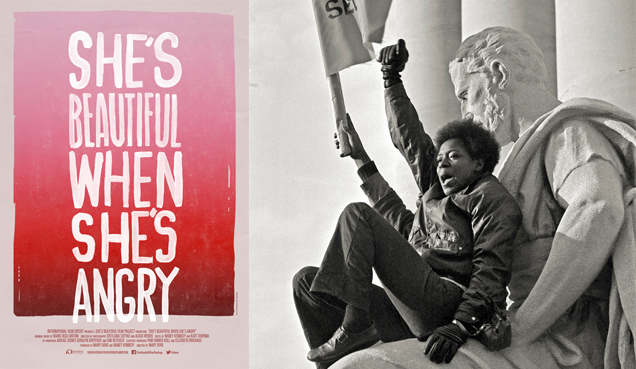Throughout our lives we experience a constant search of our identity. A part of that search is how we describe ourselves to others. It can be adjectives or nouns concerning our appearances and personalities that we believe will reveal something about who we are. Identifying yourself as a feminist is however more difficult than stating that you’re “blonde”, “tall” or “outgoing”. Not only will you have to explain what that word means to you to people who misinterpret it, but your own understanding of it might get challenged by new information and other people’s opinions.

She’s Beautiful When She’s Angry (Dore & Kennedy, 2014
The term “feminist” for some people associates with words like “controversial” or “women-favouring”. Unfortunately, some feminist works still reinforce these stereotypes. An excellent example is the movie She’s Beautiful When She’s Angry (Dore & Kennedy, 2014). By focusing on the most visually striking protests and problems concerning the majorities, the movie reinforces the stereotype of feminists being “controversial” or “aggressive”. Moreover, it conforms to the concept of “White Feminism” by focusing on white feminists and their communities. With small exceptions the movie ignores the voices of other ethnicities, genders and backgrounds.
Some of the most influential feminist authors are beginning to understand how feminism can conform to what it originally aimed to change. Nancy Fraser in her article “How feminism became capitalism’s handmaiden – and how to reclaim it” (2013) has stated the following:
 “As I see it, feminism’s ambivalence has been resolved in recent years in favour of the second, liberal-individualist scenario – but not because we were passive victims of neoliberal seductions. On the contrary, we ourselves contributed three important ideas to this
“As I see it, feminism’s ambivalence has been resolved in recent years in favour of the second, liberal-individualist scenario – but not because we were passive victims of neoliberal seductions. On the contrary, we ourselves contributed three important ideas to this
development.”
As we can see, the author believes that by trying to liberate themselves from oppression of social norms, feminists unknowingly contributed to the development of neo-liberalism, which praises individuality and free market. That has resulted in the downplay of social solidarity and what Nancy Fraser calls “carework”. It seems however that the author is still missing some of the drawbacks of the second-wave feminism.
Claims made by Fraser in her article have even received a response from Brenna Bhandar and Denise Ferreira da Silva in their article “White Feminist Fatigue Syndrome” (2013), in which the authors asked:
“Are the White feminists who persist in throwing in the word “race” or “racism” in their otherwise left-liberal approaches to feminism willfully blind/deaf? Are they unable to cede the floor to Black feminism because it would mean the loss of a certain racial privilege?”
This brings us again to the concept of “white feminism”, and the idea of non-white feminists contributions being ignored. That is why Bhandar and Silva bring our attention to why we should try to decolonize feminism, which means fighting both the favouring of “First World” feminism and paying attention solely to what it’s trying to fight. Feminists need to remember to think broader, to expand their thinking to other parts of the world and pay attention to and respect the contributions of activists from the “Third World”.
As we can see by the above examples, the term feminism is a very complex one, and consequently we need to stay open-minded to changes that other views or perspectives might bring to our understanding of that word. Moreover, we need to relentlessly aim to achieve equality and consciousness so that all feminists can learn how to accomplish their goals together, instead of battling or silencing each other.
Sources:
- Nancy Fraser (2013), “How feminism became capitalism’s handmaiden – and how to reclaim it”, The Guardian, retrieved from: https://www.theguardian.com/commentisfree/2013/oct/14/feminism-capitalist-handmaiden- neoliberal
- Brenna Bhandar and Denise Ferreira da Silva (2013), “White Feminist Fatigue Syndrom”, Critical Legal Thinking: Law and the Political, retrieved from: http://criticallegalthinking.com/2013/10/21/white-feminist-fatigue-syndrome/
- Mary Dore (director), Mary Dore & Nancy Kennedy (producer) (2014), “She’s Beautiful When She’s Angry”, retrieved from: http://www.shesbeautifulwhenshesangry.com
- http://outraspalavras.net/outrasmidias/destaque-outras-midias/como-certo-feminismo-mordeu-a-isca-neoliberal/
- http://www.creativealliance.org/events/2015/shes-beautiful-when-shes-angry